Silver Falls State Park
Silver Falls State Park is a state park in the U.S. state of Oregon, located near Silverton, about 20 miles (32 km) east-southeast of Salem. It is the largest state park in Oregon with an area of more than 9,000 acres (36 km2), and it includes more than 24 miles (39 km) of walking trails, 14 miles (23 km) of horse trails, and a 4-mile (6.4 km) bike path. Its 8.7-mile (14.0 km) Canyon Trail/Trail of Ten Falls runs along the banks of Silver Creek and by ten waterfalls, from which the park received its name. Four of the ten falls have an amphitheater-like surrounding that allows the trail to pass behind the flow of the falls.[2] The Silver Falls State Park Concession Building Area and the Silver Creek Youth Camp-Silver Falls State Park are separately listed on the U.S. National Register of Historic Places.
| Silver Falls State Park | |
|---|---|
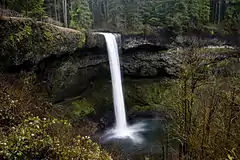 South Falls | |
 | |
| Type | Public, state |
| Location | Marion County, Oregon |
| Nearest city | Silverton |
| Coordinates | 44°51′04″N 122°38′46″W[1] |
| Operated by | Oregon Parks and Recreation Department |
The park's most visited waterfall is South Falls, a 177-foot (54 m) cascade.[3] Remote Double Falls, however, is listed as the highest waterfall in the park, plunging 178 feet (54 m) in a small tributary side canyon deep within the Silver Creek Canyon.
History
Silver Falls State Park Concession Building Area | |
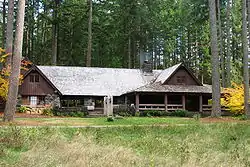 Silver Falls Lodge | |
| Nearest city | Sublimity, Oregon |
|---|---|
| Built | 1934 |
| Architect | J. Elwood Isted |
| NRHP reference No. | 83002164[4] |
Silver Creek Youth Camp – Silver Falls State Park | |
| Nearest city | Sublimity, Oregon |
| Coordinates | 44°51′23″N 122°36′31″W |
| Built | 1936 |
| Architect | Keith R. Maguire, Jr. |
| Architectural style | National Park Service rustic |
| NRHP reference No. | 02000673[4] |
| Added to NRHP | June 20, 2002 |
| Added to NRHP | June 30, 1983 |
Silver Falls City formed in 1888 and was primarily a logging community with a few homesteaders, and the area was extensively logged. The small lumber town of Silver Falls City sat atop the South Falls, and as the land was cleared, a local entrepreneur sold admission to the Falls area,[5] with attractions such as pushing cars over the falls and even hosting a stunt with a daredevil riding over in a canoe.
By 1900 a Silverton photographer, June D. Drake, began to campaign for park status, using his photographs of the falls to gain support. (Drake Falls was later named for him.)[6] In 1926, however, an inspector for the National Park Service rejected the area for park status because of a proliferation of unattractive stumps after years of logging.
In 1935 President Franklin D. Roosevelt announced that the Silver Falls area would be turned into a Recreational Demonstration Area. Private land that had been logged was purchased, and workers in the Civilian Conservation Corps were employed to develop park facilities, including the historic South Falls Lodge, completed in the late 1930s. It was used as a restaurant from 1946 until the late 1950s and was listed on the National Register of Historic Places as the Silver Falls State Park Concession Building Area in 1983.[7] The Silver Creek Youth Camp—Silver Falls State Park was also added to the National Register at this time.
In January 2008, during the 2008 supplemental legislative session, Fred Girod of the Oregon House of Representatives sought federal designation of the area as a national park via a house joint memorial to the United States Congress, but the bill died in committee.[8]
Geology
The history of the canyon's formation begins about 26 million years ago to the Oligocene period, when most of Oregon was covered by ocean. After the waters of the ocean receded about 15 million years ago, the flood basalt flows of the Columbia River Basalt Group covered the sandstone that had been the ocean floor. The softer layers of sandstone beneath the basalt sheet eroded over time, creating pathways behind some of the waterfalls that Civilian Conservation Corps workers widened to make safe for public use. Another geologic feature are many tree "chimneys" or casts, formed when hot lava engulfed living trees and disintegrated them.[9]
Waterfalls
Within the park are many waterfalls, including ten along the Trail of Ten Falls (marked * in the table below) and five more below the confluence of the North and South forks of Silver Creek. [10] The South Fork has an average flow rate of 75 cu ft/s (2.1 m3/s), and the North Fork has an average flow rate of 100 cu ft/s (2.8 m3/s). The Trail of Ten Falls passes behind the falls of South Falls, Lower South Falls, Middle North Falls, and North Falls.
| Waterfall | Image | Distance on trail | Coordinates | Stream | Height |
|---|---|---|---|---|---|
| South Falls* | 0.0 | 44.8788°N 122.6589°W | South Fork | 177 feet (54 m)[11][12] | |
| Lower South Falls* |  |
0.8 | 44.8853°N 122.6609°W | South Fork | 93 feet (28 m)[13][14] |
| (Confluence of N. & S. Forks) | 1.1 | Silver Creek | (N/A) | ||
| Lower North Falls* | 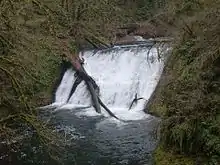 |
2.1 | 44.8914°N 122.6464°W | North Fork | 30 feet (9.1 m)[15] |
| Double Falls* | 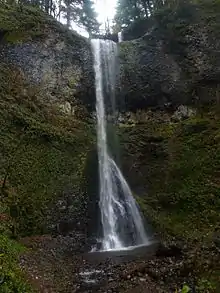 |
2.1 + 0.1 on side trail | 44.8920°N 122.6450°W | Hullt Creek | 178 feet (54 m)[16] |
| Drake Falls* | 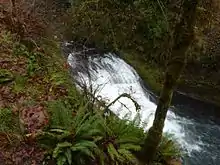 |
2.3 | 44.89°N 122.6461°W | North Fork | 27 feet (8.2 m)[17][18] |
| Middle North Falls* | 2.5 | 44.8886°N 122.6431°W | North Fork | 106 feet (32 m)[19][20] | |
| Winter Falls* | 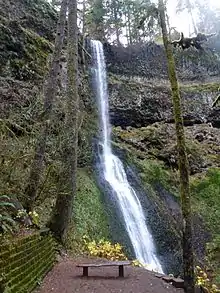 |
2.7 + 0.5 on side trail | 44.8844°N 122.6408°W | Winter Creek | 134 feet (41 m)[21][22] |
| Twin Falls* | .jpg.webp) |
3.0 | 44.8852°N 122.6370°W | North Fork | 31 feet (9.4 m)[23] |
| North Falls* | _(marDA0136).jpg.webp) |
3.9 | 44.8849°N 122.6227°W | North Fork | 136 feet (41 m)[24] |
| Upper North Falls* | .jpg.webp) |
4.6 | 44.8831°N 122.6142°W | North Fork | 65 feet (20 m)[25] |
| Crag Falls | 1.1 + ? below confluence | Silver Creek | 12 feet (3.7 m) | ||
| Elbow Falls | 1.1 + ? below confluence | Silver Creek | 20 feet (6.1 m) | ||
| Canyon Falls | 1.1 + ? below confluence | Silver Creek | 10 feet (3.0 m) | ||
| Lisp Falls | 1.1 + ? below confluence | Silver Creek | 5 feet (1.5 m) | ||
| Sunlight Falls | 1.1 + ? below confluence | Silver Creek | 5 feet (1.5 m) | ||
| Frenchie Falls[26] | (just before start of trail) | Frenchie Creek | 48 feet (15 m) | ||
| Trickle Falls | (3.5 above start of trail) | Tributary of S. Fork | ? |
Wildfires
Between July 13th and 28th, a wildfire broke out in the eastern timbered area of Silver Falls State Park. The blaze grew to 27 acres and was mostly contained by July 15th. The State Park remained open for visitors to the falls but the campgrounds were closed for a short period. It was thought that the fire was the result of a lightning strike which smoldered for about a month before igniting. [27] In September of 2020, the Beachie Creek Fire came into the eastern and southern edges of the park. The fire was slowed by a reversal of the winds to the south and east and Oregon fire crews were able to contain the blaze, one of the largest and most destructive in state history. Other historic fires-- 1865:The Silverton Fire, the largest known in Oregon’s history, burned a million acres including the Silver Falls area. 1886:A forest fire destroyed a large part of the forest on lands that would become Silver Falls State Park. 1925:September: A destructive forest fire raged near and at House Mountain. 1928:Summer: South Burn, a forest fire, damaged the Silver Falls area. [28]
Friends of Silver Falls
Volunteers inspired by the beauty and history of Silver Falls have been active there since establishment of the park in 1933. In 1986, the citizens and the park staff envisioned a mission and established the Friends of Silver Falls State Park, Inc. That mission is "to further the educational and interpretive opportunities available to park visitors; to promote the preservation, protection and enhancement of the historical, natural, and recreational resources within the park; and to assist in the implementing park improvements and educational programs compatible with the nature of Silver Falls State Park."[29]
As a result, this private and public partnership has created a more meaningful park experience for the nearly one million annual visitors to the park, far beyond what state park funding alone can provide.[29]
Since 1992, volunteers of the Friends of Silver Falls State Park have operated the Nature Store in historic South Falls Lodge. This store offers a variety of books, clothing and souvenirs in keeping with the park's nature theme. The organization has also been responsible for much of the interpretive signage along the Trail of Ten Falls.[29]
Other goals of the Friends include compiling oral histories from those who have memories of the park region, keeping alive the history of Silver Falls City, recognizing the work of the Civilian Conservation Corps and the Works Progress Administration in the 1930s and 1940s, maintaining the park's historic district, and continuing to place interpretive signs throughout the park's more than 9,000 acres (36 km2).[29]
In culture
The park has been used as a filming location in several movies. The 1981 horror film Just Before Dawn was shot entirely on location in the park;[30] it also served as a filming location for William Friedkin's thriller The Hunted (2003), and the blockbuster film Twilight (2008).
References
- "Silver Falls State Park". Geographic Names Information System. United States Geological Survey. Retrieved 2011-06-26.
- "Silver Falls State Park". Oregon Parks and Recreation Department. Retrieved September 1, 2007.
- "Recreation in Salem Oregon". Salem, Oregon Convention & Visitors Association. Archived from the original on November 22, 2006. Retrieved January 28, 2007.
- "National Register Information System". National Register of Historic Places. National Park Service. April 15, 2008.
- "A brief history of Silver Falls State Park". Friends of Silver Falls.
- Engeman, Richard H. (2009). The Oregon Companion: An Historical Gazetteer of The Useful, The Curious, and The Arcane. Portland, Oregon: Timber Press. p. 123. ISBN 978-0-88192-899-0.
- "Oregon Hikes - Silver Falls". Retrieved September 1, 2007.
- "House Joint Memorial 101". Oregon Legislative Assembly. 2008. Retrieved December 31, 2008.
- "Silver Falls Trailmap" (PDF). Oregon Parks and Recreation Department. Retrieved September 1, 2007.
- Freed, Michael (January 1979). "Silver Falls State Park" (PDF). Oregon Geology. Portland: Oregon Department of Geology and Mineral Industries. 41 (1): 3–10. Retrieved April 19, 2009.
- "South Falls Marion County, Oregon". Northwest Waterfall Survey. Retrieved 6 May 2017.
- "South Falls". World Waterfall Database. Retrieved 5 May 2017.
- "Lower South Falls Marion County, Oregon". Northwest Waterfall Survey. Retrieved 6 May 2017.
- "Lower South Falls". World Waterfall Database. Retrieved 5 May 2017.
- "Lower North Falls Marion County, Oregon". Northwest Waterfall Survey. Retrieved 6 May 2017.
- "Double Falls Marion County, Oregon". Northwest Waterfall Survey. Retrieved 6 May 2017.
- "Drake Falls Marion County, Oregon". Northwest Waterfall Survey. Retrieved 6 May 2017.
- "Drake Falls". World Waterfall Database. Retrieved 5 May 2017.
- "Middle North Falls Marion County, Oregon". Northwest Waterfall Survey. Retrieved 6 May 2017.
- "Middle North Falls". World Waterfall Database. Retrieved 5 May 2017.
- "Winter Falls Marion County, Oregon". Northwest Waterfall Survey. Retrieved 6 May 2017.
- "Winter Falls". World Waterfall Database. Retrieved 5 May 2017.
- "Twin Falls Marion County, Oregon". Northwest Waterfall Survey. Retrieved 22 May 2017.
- "North Falls Marion County, Oregon". Northwest Waterfall Survey. Retrieved 6 May 2017.
- "Upper North Falls Marion County, Oregon". Northwest Waterfall Survey. Retrieved 6 May 2017.
- Swan, Bryan. "Frenchie Falls". Northwest Waterfall Survey. Retrieved 4 November 2012.
Frenchie Falls is the black sheep 11th waterfall along the Trail of Ten Falls within Silver Falls State Park.
- {{cite web|url=https://www.oregon.gov/ODF/Board/Documents/BOF/20180905/BOFMIN_20180905_ATTCH01_2018%20Fire%20Season%20BOF%20Presentation.pdf
- {{cite web|url= https://silverfallswordfromthewoods.files.wordpress.com/2013/08/silver-falls-history_draft-july-2011.pdf
- "Friends of Silver Falls". Retrieved December 30, 2008.
- Just Before Dawn: Lions, Tigers and Inbred Twins Documentary [DVD]. Shriek Factory/Media Blasters. 2005.
External links
| Wikimedia Commons has media related to Silver Falls State Park. |
- "Silver Falls State Park". Oregon Parks and Recreation Department. Retrieved 2011-06-26.
- "Silver Falls State Park". Oregon Tourism Commission. Retrieved 2011-06-26.
- "Friends of Silver Falls State Park". Retrieved 2011-06-26.